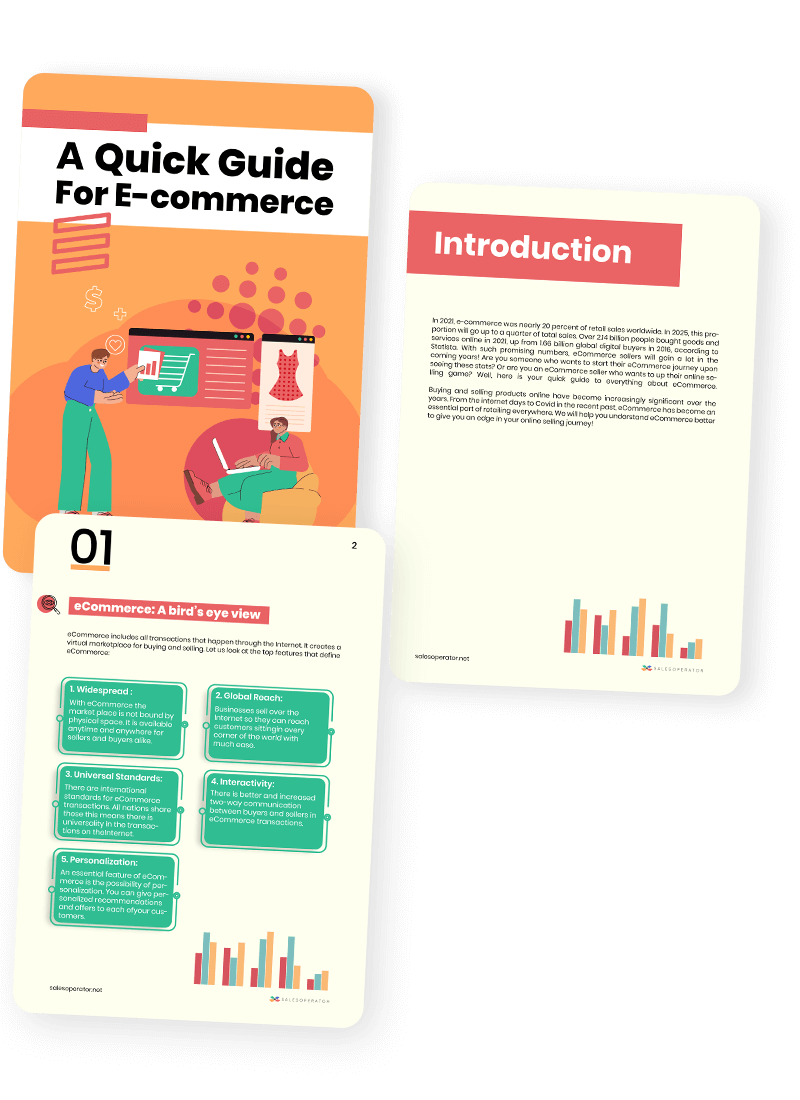Multi-channel e-commerce is the process of selling physical products or services through different channels simultaneously, such as websites, mobile apps, social media platforms, and digital marketplaces like Amazon, eBay, Etsy etc. This article’s main goal is to examine the numerous multi-channel marketing strategy that companies may use to successfully connect with and engage with their target market.
Implementing Multichannel Marketing: Challenges Galore
Like any other ecommerce business seller, you have the desire to see your business grow and profits soar. Investing in multichannel can help your ecommerce business get to the next level, but it can also come with its fair share of challenges. But don’t worry, We have created a multi-channel marketing strategy that integrates the best methods for connecting with customers across many platforms.
Benefits of Multi-channel E-commerce
Multichannel e-commerce allows businesses to expand their reach and boost sales by offering their products through various channels. By being present on multiple platforms, businesses can increase their visibility and make it easier for customers to find and purchase their products. Different channels may appeal to different demographics, so using multiple channels can be especially effective for businesses targeting specific groups of customers. For example, a fashion business might have greater success selling through social media platforms like Instagram, which are popular with younger consumers, rather than through traditional e-commerce websites.

To succeed in multi-channel ecommerce selling, you need to put a solid plan in place to tackle these challenges in multi-channel marketing strategy head on. Here are the top five challenges in multi channel marketing strategy that you’ll probably face:
1. Managing Data And Analytics
One of the most significant challenges facing multichannel ecommerce businesses is the difficulty of tracking and managing data across various channels. When selling through various channels, such as a website, mobile app, social media platforms, Amazon, and eBay, it can be challenging in multi-channel marketing strategy to track and manage data accurately related to inventory levels in real time. It can be difficult to keep track of sales and orders from each channel and how they are affecting inventory levels.

These tasks are critical to smooth operation of a business as they help to ensure that orders are fulfilled and shipped to the correct addresses in a timely manner, and that inventory levels are accurately reflected across all channels. However, managing these tasks manually can be difficult and may require the use of multiple systems and technologies, which can be resource-intensive and prone to errors. By using multi-channel software, businesses can streamline these processes and make it easier to track and manage data across all channels in real-time through a single dashboard.
Managing Routine Tasks
The final issue e-commerce retailers experience when it comes to selling multichannel is time. For example, take a simple example of product listing on Amazon and ebay is a slow and time taking process as it requires matching up all images with right products and product descriptions. Just imagine if you have hundreds of products and multiple channels, how much time it will take to optimize titles and keywords and images on each channel.
Overselling And Overstocking
Overselling in multi-channel e-commerce refers to the situation where a business sells more units of a product than it has available in stock. This can occur when a business is selling the same products across multiple channels, and an order is placed on one channel while another order for the same product is being fulfilled on a different channel. If the business is not carefully tracking its inventory levels and sales across all channels, it may end up overselling to customers and not being able to fulfil all of the orders placed.
For example, if a customer places an order for a product on your website, and that product is also being sold through other channels such as Amazon or eBay, it is possible that the product could be sold out on one channel while still being available for sale on another if the data is not instantly updated on each channel.
When a business oversells a product, it can lead to delays in fulfilling orders and result in unhappy customers. Customers may become frustrated if they have to wait longer than expected for their orders to be fulfilled, or if their orders are cancelled altogether. This can lead to a loss of trust and loyalty, and it can damage the reputation of the business.
In addition, not optimizing and updating each channel separately can result in cancellations, order delays, poor customer across the sales channels. Furthermore, manual tracking of inventory takes a lot of time and restricts 360-degree visibility while also complicating inventory and order management. As a result, the instances of manual errors and unassigned stocks keeps on increasing.
2. Delivering Exceptional Customer Experience
Supporting and cultivating relationships with customers become more challenging in multi-channel marketing strategy when a business starts selling on various platforms, such as Amazon, eBay, Etsy, Facebook, Alibaba, and other online marketplaces.
If the customer experiences different levels of service or conflicting information depending on the channel they use, it can lead to frustration and a negative customer experience. However, achieving this objective is easier said than.
3. Selecting Right Channels and Striking a Balanced Approach
In multi-channel marketing strategy, choosing the appropriate channels and adopting a balanced strategy is crucial because it directly affects how well your marketing campaigns perform.
As a business, it is essential to carefully consider the various e-commerce channels available and choose those that align with your business goals and target audience. This means thoroughly reviewing the requirements and characteristics of each channel, and establishing connections that facilitate efficient inventory management, logistics, and ongoing monitoring. Failing to do so can result in missed opportunities and a higher risk of failure in the e-commerce market. By taking the time to properly connect to the right channels, you can set your business up for success in the fast-paced and constantly evolving world of e-commerce.
Moreover, having too few channels can limit the reach and potential customer base of the business, as well as make it difficult to serve customers in different geographic locations or markets. On the other hand, having too many channels can be overwhelming, tedious, and time-consuming to manage, and it dilutes your limited resources and efforts.
4. Continuous Monitoring On Various Channels
Any successful multi-channel marketing strategy must incorporate ongoing channel monitoring. Continuously monitoring and analyzing a multi-channel e-commerce strategy can be a big challenge for businesses for a number of reasons. The main challenge is the sheer amount of data that needs to be collected and analyzed—right from sales, revenue, orders, inventory, shipping and customer reviews. With so many different channels to track and compare, it can be difficult for businesses to get a clear and comprehensive picture of their sales, customer behaviour, and overall performance. Additionally, the data collected from different channels may not always be directly comparable, making it harder to draw accurate conclusions from it.
Just imagine how challenging it will be to switch constantly between different channels and login into websites and update inventory, orders, and shipping related data on each and map the data accurately. Despite all your efforts, the chance of making mistakes will increase proportionately.
5. Maintaining Consistent Brand Message Across Channels
While it is relatively easy to control and track messaging and branding when only selling products on a single channel, such as a company’s own website, managing consistency across multiple channels can be more difficult. Each channel has its own requirements, nuances, and best practices, and it is important for businesses to create the same strong first impression on new channels as they do on their own website and online store.
For instance, Amazon has the best practices that guides sellers on how to create product detail pages. Similarly, Etsy has its own requirements and best practices for adding images to product listing pages. Also, coordinating among multiple channels can be difficult.
One of the biggest challenges in a multi-channel marketing strategy is maintaining a consistent brand message across many platforms, but it is essential for developing brand awareness and trust. To ensure a consistent branding across each channel, it is important to put a clear roadmap in place that can be implemented whenever updates are needed.
Final Words
Managing multiple channels can be a demanding task for any business. It requires the development of unique strategies and tactics for each channel, as well as ongoing maintenance and updates. These tasks can be time-consuming and can make it difficult for businesses to keep up with the demands of multiple channels while still running their operations and serving their customers. It is important for businesses to carefully consider the resources and time required for multichannel management before expanding their presence to multiple channels. Utilizing our multi-channel marketing strategy, you may raise brand awareness, boost participation, and finally accomplish your marketing objectives.




